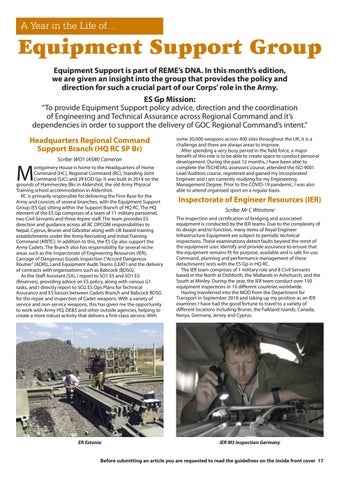A Year in the Life of…
Equipment Support Group Equipment Support is part of REME’s DNA. In this month’s edition, we are given an insight into the group that provides the policy and direction for such a crucial part of our Corps’ role in the Army. ES Gp Mission: “To provide Equipment Support policy advice, direction and the coordination of Engineering and Technical Assurance across Regional Command and it’s dependencies in order to support the delivery of GOC Regional Command’s intent.” Headquarters Regional Command Support Branch (HQ RC SP Br) Scribe: WO1 (ASM) Cameron
M
ontgomery House is home to the Headquarters of Home Command (HC), Regional Command (RC), Standing Joint Command (SJC) and 29 EOD Gp. It was built in 2014 on the grounds of Hammersley Bks in Aldershot, the old Army Physical Training school accommodation in Aldershot. RC is primarily responsible for delivering the Firm Base for the Army and consists of several branches, with the Equipment Support Group (ES Gp) sitting within the Support Branch of HQ RC. The HQ element of the ES Gp comprises of a team of 11 military personnel, two Civil Servants and three Aspire staff. The team provides ES direction and guidance across all RC OPCOM responsibilities to Nepal, Cyprus, Brunei and Gibraltar along with UK based training establishments under the Army Recruiting and Initial Training Command (ARITC). In addition to this, the ES Gp also support the Army Cadets. The Branch also has responsibility for several niche areas such as the Inspectorate of Engineering Resources (IER), Carriage of Dangerous Goods inspection (“Accord Dangereux Routier” (ADR)), Land Equipment Audit Teams (LEAT) and the delivery of contracts with organisations such as Babcock (BDSG). As the Staff Assistant (SA), I report to SO1 ES and SO1 ES (Reserves), providing advice on ES policy, along with various G1 tasks, and I directly report to SO2 ES Ops Plans for Technical Assurance and ES liaison between Cadets Branch and Babcock BDSG for the repair and inspection of Cadet weapons. With a variety of service and non-service weapons, this has given me the opportunity to work with Army HQ, DE&S and other outside agencies, helping to create a more robust activity that delivers a first-class service. With
ER Estonia
some 30,000 weapons across 400 sites throughout the UK, it is a challenge and there are always areas to improve. After spending a very busy period in the field force, a major benefit of this role is to be able to create space to conduct personal development. During the past 12 months, I have been able to complete the TECHEVAL assessors’ course, attended the ISO 9001 Lead Auditors course, registered and gained my Incorporated Engineer and I am currently studying for my Engineering Management Degree. Prior to the COVID-19 pandemic, I was also able to attend organised sport on a regular basis.
Inspectorate of Engineer Resources (IER) Scribe: Mr C Winstone The inspection and certification of bridging and associated equipment is conducted by the IER teams. Due to the complexity of its design and/or function, many items of Royal Engineer Infrastructure Equipment are subject to periodic technical inspections. These examinations detect faults beyond the remit of the equipment user, identify and provide assurance to ensure that the equipment remains fit for purpose, available and is safe for use. Command, planning and performance management of these detachments’ rests with the ES Gp in HQ RC. The IER team comprises of 1 military role and 8 Civil Servants based in the North at Dishforth, the Midlands in Ashchurch, and the South at Minley. During the year, the IER team conduct over 150 equipment inspections in 10 different countries worldwide. Having transferred into the MOD from the Department for Transport in September 2018 and taking up my position as an IER examiner, I have had the good fortune to travel to a variety of different locations including Brunei, the Falkland Islands, Canada, Kenya, Germany, Jersey and Cyprus.
IER M3 Inspection Germany
Before submitting an article you are requested to read the guidelines on the inside front cover 17











